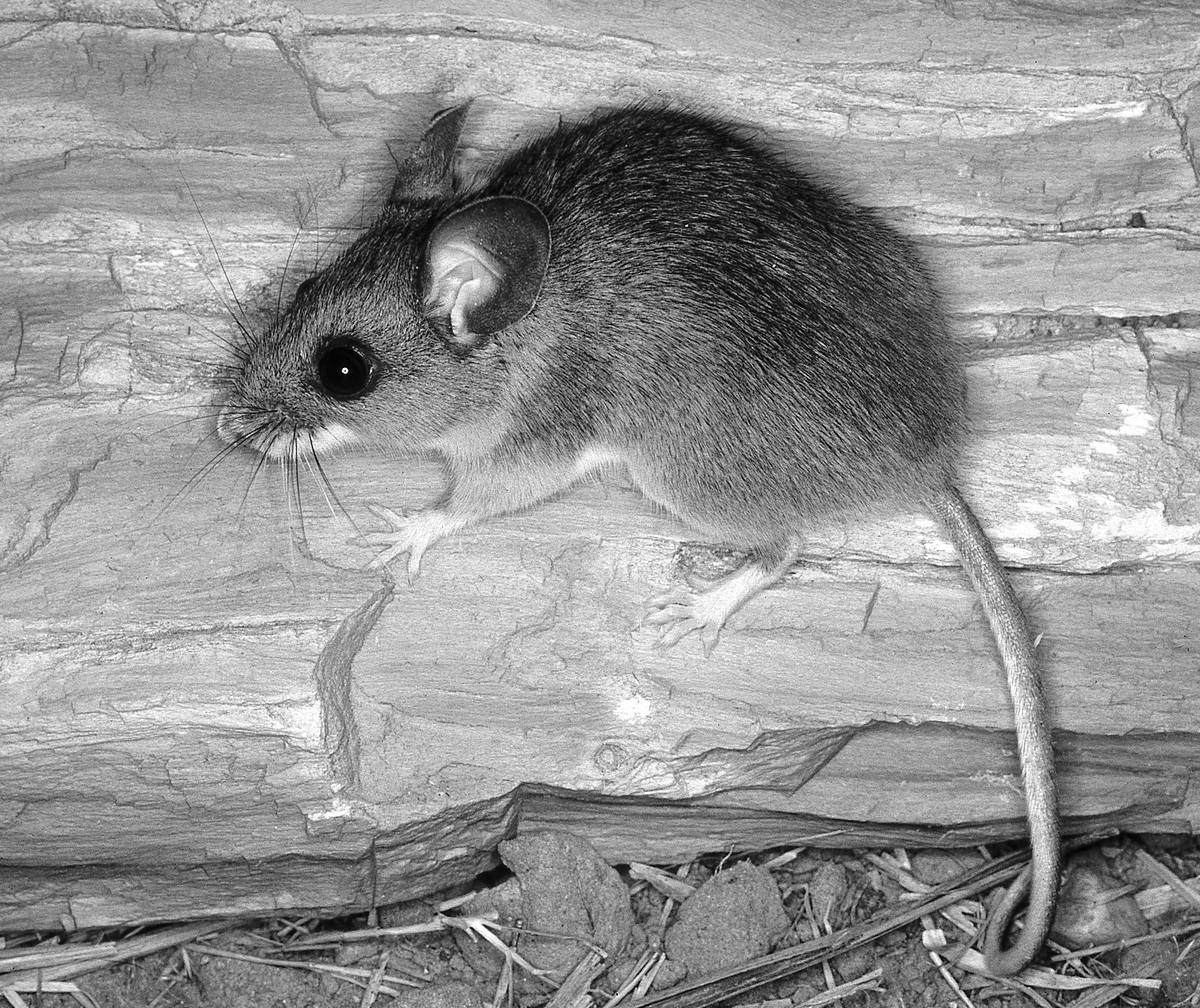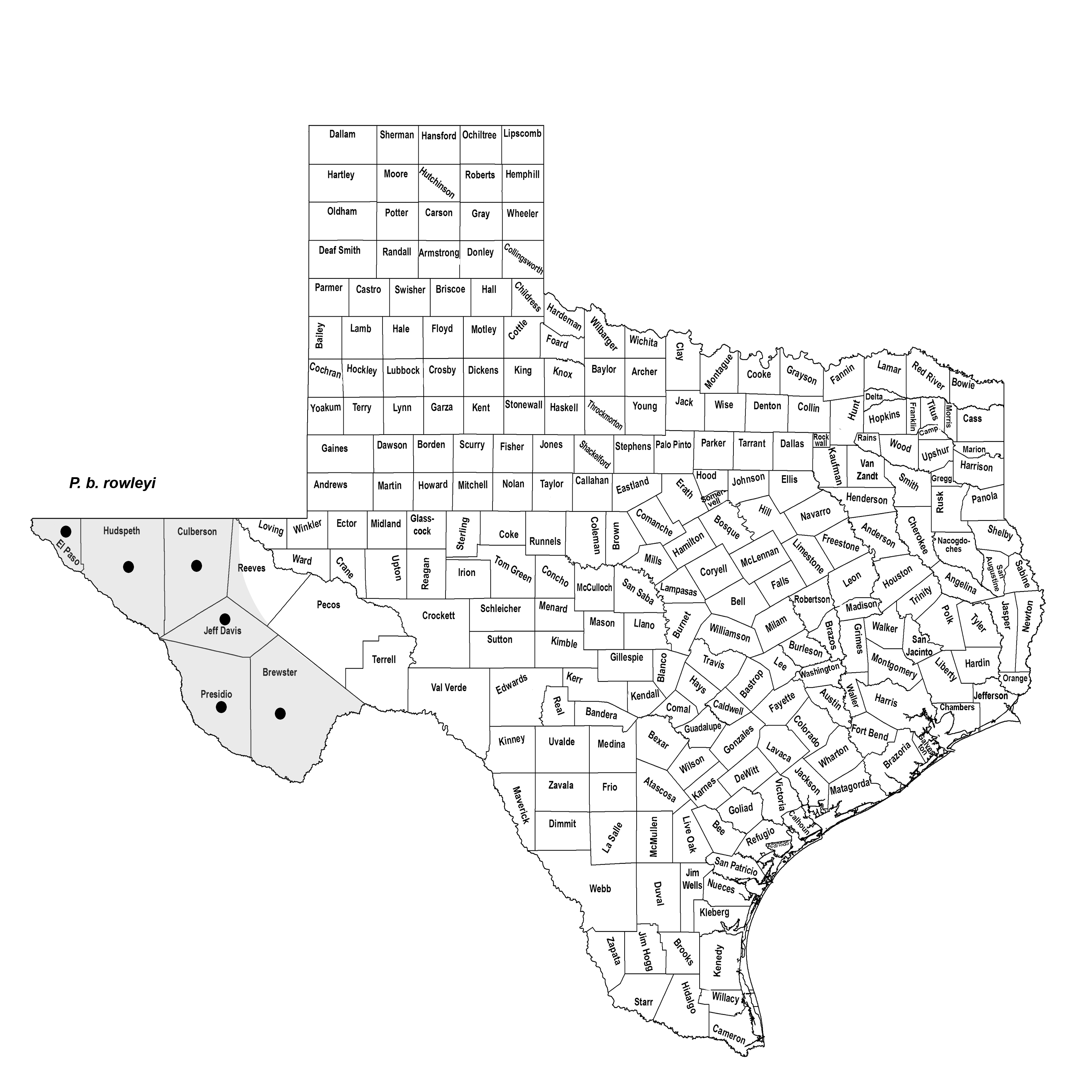BRUSH DEERMOUSE
Peromyscus boylii (Baird 1855)
Order Rodentia : Family Cricetidae
DESCRIPTION. A medium-sized, long-tailed deermouse; tail equal to or longer than head and body, sparsely haired, slightly tufted, and indistinctly bicolor, darker above; ankles dusky, the feet white; ears moderately long (19–22 mm from notch); proximal two-fifths of sole of hind foot hairy; upperparts pale cinnamon or hair brown to sepia; sides with narrow ochraceous buff lateral line; underparts white. Dental formula: I 1/1, C 0/0, Pm 0/0, M 3/3 × 2 = 16. Averages for external measurements: total length, 197 mm; tail, 103 mm; hind foot, 22 mm. Weight, 22–36 g. Distinguished from P. nasutus by smaller ears and shorter fur; from P. laceianus by dusky instead of white ankles.

DISTRIBUTION. Western Trans-Pecos region.

SUBSPECIES. Peromyscus b. rowleyi.
HABITS. These deermice are usually associated with brush and trees above 2,500 m, but they have been trapped in a number of habitats including stream banks, rock walls, talus slopes, and cabins. In the Guadalupe Mountains of western Texas, they are common in the open pine–fir forest at 2,400 m (7,874 ft.) where they show a decided preference for areas of down logs and brush piles. Vernon Bailey remarked that they seldom burrow into the ground but rather utilize any natural cavity that offers concealment and protection. The nest is a globular structure of dry plant fibers, mostly grasses.
They are very adept at climbing and seem to be at home off the ground. Without doubt they garner much of their food in trees and utilize hollows in them for dens. They are almost entirely nocturnal in habit and are active year-round.
They feed on a variety of plant items. In the Guadalupe Mountains, they feed extensively on pine nuts and Douglas fir seeds; in the oak belt, acorns are a favorite item. They also feed on hackberries, juniper berries, and cactus fruits.
The breeding season extends through most of the year. Pregnant females have been taken from May to December, but the presence of half-grown pups in May indicates that breeding begins as early as March or April. Several litters of two to five (average three) young may be reared in a year, but the peak of production is in spring and early summer. The young are blind and hairless and weigh about 2 g at birth.
Usually these deermice are of little or no economic importance, except in instances where they occur in numbers around and in cabins and granaries in wooded areas.
POPULATION STATUS. Common. The brush deermouse is common in the high-elevation habitats of the Trans-Pecos region.
CONSERVATION STATUS. The IUCN lists the brush deermouse as a species of least concern, and it does not appear on the federal or state lists of concerned species. It does not appear to face any serious threats.
Remarks. Earlier versions of this book listed records of this species from the eastern escarpment of the Llano Estacado and in adjacent parts of the Panhandle. However, in 1997, Larry Choate of Texas Tech University examined all specimens of long-tailed deermice from this region, and he is convinced they all are P. attwateri. Thus, P. boylii is restricted in distribution to the Trans-Pecos part of the state. On the Llano Estacado, it occurs only on the northwestern part of the escarpment in New Mexico, just to the west of the Texas state line.
Given the somewhat peridomestic nature of these mice and the recent association with hantaviruses, this species should be handled with caution.
From The Mammals of Texas, Seventh Edition by David J. Schmidly and Robert D. Bradley, copyright © 1994, 2004, 2016. Courtesy of the University of Texas Press.
Natural Science Research Laboratory
-
Address
Museum of Texas Tech University, 3301 4th street, Lubbock, TX 79409 -
Phone
806.742.2486 -
Email
nsrl.museum@ttu.edu

